Official Name
Iaşi (pronounced 'Yush') in Romanian. Occasionally you may also see the old spelling Jassy . According to Xenopol (a Romanian researcher), the name might derive from the Slavic name Askytorg. Since Iaşi lies in Moldavia, ie Eastern Romania, there was almost no German and Hungarian influence at all - hence, there's no German or Hungarian name for the place.
Location

| ||
| Iaşi |
Iaşi marks the centre of the historic province Moldavia and is 300 km away as the crow flies from →Bucharest to the north. The border to the →Republic of Moldova to the east is only 20 km away. The area around the town is rather hilly with large parts being used as farmland. The small river Bahlui crosses the southern part of the city.
Population
Almost 350,000 people live in Iaşi, making it the third-largest city in Romania, only to be outnumbered by →Bucharest and Constanţa.
Orientation
The town spreads out in a river valley and is slightly chaotic. The valley is flanked by more or less small mountains, with some monasteries towering above the city on the top of them. The centre of town concentrates around Piaţa Unirii (Union Square). The square itself is surrounded by surprisingly ugly concrete buildings. The busy train station is only around 700 metres away from the square in the west. A smaller bus terminal and a large tram stop are conveniently located in front of the train station. From Piaţa Unirii, Iaşi's most elegant street called Blvd. Ştefan cel Mare şi Sfânt (St Stephen the Great blvd) runs eastwards. Several modern shops and restaurants as well as some churches line up along this road. At the end of the boulevard stands the giant Palace of Culture.
When you walk from Piaţa Unirii to the north-west, pass Piaţa Eminescu and walk straight ahead along Blvd. Copou, you will soon pass some university buildings. From there, it's only a short walk to the large Botanical Garden of Iaşi. The old town is quite compact, but if you want to see all the sights in and around Iaşi including the monasteries and the Botanical Garden, you'll need plenty of time and good shoes or a taxi and/or public transport.
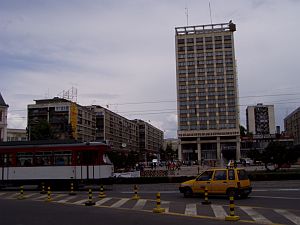
| ||
| The not particularly beautiful centre around Union Square |
Getting there / transportation
By bus or by train. Several trains connect the town with many other big cities in Romania, as for example →Cluj-Napoca (9 hrs, 31.5 Lei with the Acc.), which stops halfway in →Suceava (2 hrs from Iasi). There are also some daily direct trains to →Bucharest.
There's also a direct train to the →Republic of Moldova. The ride to the capital →Chişinău (Kishinev) takes around six hours (due to a different gauge, wheels need to be adjusted at the border, which takes up to 3 hrs). Some of the trains continue to →Kiev (Kyiv) and even further to Moscow. The minibus to Chişinău takes less than 5 hours and continues to →Orhei north of the capital. The fare to Kishinev is 17 Lei (€ 4).
Attention: The minibus to Moldova doesn't leave from the bus station opposite the train station but from Autogară Vest, which is a few tram stops away from the train station. Guess which direction. There are three buses a day: at 7:45, 10:00 and 15:45. Tickets aren't sold in advance. The bus also stops in front of the Billa Supermarkt close to the train station, but since seats are limited it's better to start from the western bus station.
Iaşi didn't really develop a lot before the second half of the 14th century. But ever since, the location at the crossroads of several trade routes allowed quick development. After several bloody battles against the advancing Hungarians, the Moldavian Empire was established around Iaşi. Ştefan cel Mare (Stephen the Great), who is still revered as a national hero in Eastern Romania and in wide parts of present-day →Moldova, led the struggle against the Turks here in Iaşi at the end of the 15th century.
In 1859, Moldova united with Wallachia, forming the first modern Romanian country. Due to a lack of alternatives, Iaşi became the first capital of Romania, but only for three years. At the same time, in 1860, the first Romanian university, which is still quite important, was founded in Iaşi. During the First World War, Iaşi became the seat of the government again.
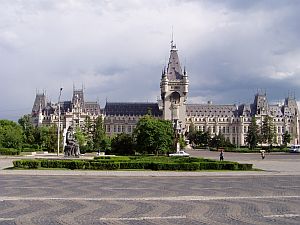
| ||
| The huge Palace of Culture in Iasi |
When you arrive at the train station and walk up the hill to Piaţa Unirii, you will probably soon feel the burning desire to leave this place as soon as possible. The central square is an ugly symphony of more or less large concrete buildings built in the 1970ies or so. But that's only the first impression - Iaşi can do much better. Walk along the main boulevard (see orientation) to the south-east and you will find yourself standing in front of the Palatul Culturii (Palace of Culture) - a huge neo-Gothic building which was erected between 1906 and 1925 atop the ruins of the former Prince's Palace. Originally, the building was used by the city administration. Today it houses four museums, among them the largest art exhibition of Romania, and a library.
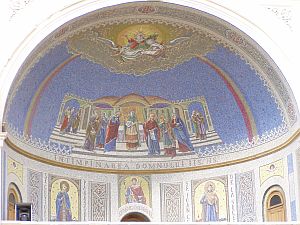
| ||
| The marvellous porch of the Moldavian Church |
There's definitely no lack of churches in Iasi: Not less than three churches almost stand next to each other at Stefan cel Mare Boulevard. The most beautiful one of the triplet is called Biserica Sfinţilor Trei Ierarhi (Church of the Three Hierarchs). The outer walls are a masterpiece of masonry, showing beautiful patterns. It's indeed very impressive (and it is said that the exterior was once covered with gold), but by now the church is under reconstruction, with scaffolding blocking the view (as of May 2004). The church was built in the 17th century, and with its appearance it resembles the famous →Cinci Mănăstiri (Five Monasteries) of the Southern Bukovina.
Opposite a small street and also facing the boulevard, there's the Roman-Catholic Church and next to that the huge Mitropolia Moldovei - the Metropolitan Cathedral of Moldavia. This church was built at the beginning of the 19th centuries, and just the dimension of the structure is very impressive. Inside the church stands the coffin containing the remainings of St Friday (no, not Robinson's Friday). The church is much frequented by believers coming to see the coffin and all the other reliquaries. By the way: At the beginning of the 20th century, about two-thirds of the citizens were Jews, making the town one of the most important centres of Jewish culture in Eastern Europe. There were 127 synagogues, but only one synagogue survived the pogroms and the shoah.
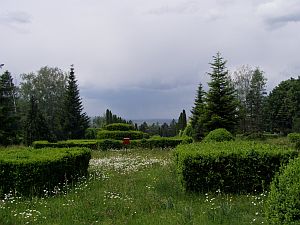
| ||
| The Botanical Garden of Iasi |
More superlatives: In the north-western part of the town you will find the 80-hectare Grădină Botanică (Botanical Garden), which is the largest of its kind in Romania. The Botanical Garden occupies a long and partially steep slope. It consists of an inner part (ie greenhouses, admission fee: 1.7 Lei) and an outer part (1 Lei, with 20 km of trails). Although we've paid for both, we were not allowed to enter large parts of the greenhouses containing all the tropical plants. Additionally, all explanations are in Romanian only. And a photo permit costs a stunning 25 Lei (€ 6). Conclusion: The Botanical Garden is definitely worth a visit, but don't expect too much. Tram No 1 direction Kopou takes you from the centre (by the way, almost all of the trams come from Halle in Germany, incl. the advertisements on the tram - you might feel like being in Germany) to the Botanical Garden. Get out as soon as you've seen the stadium on your left. A tram ticket costs 0.6 Lei.
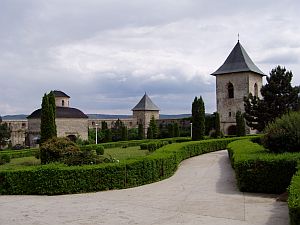
| ||
| Inside Cetăţuia Monastery |
One of the highlights of a stay in Iaşi is definitely a visit to the Mănăstirea Cetăţuia. This monastery towers above the valley on the top of a hill around 10 km south of the centre. It was built in 1672 and with its seven metres high outer walls its well fortified. Because of the strategically important location it was also used for protecting the citizens. Entrance is free, but a photo permit costs 2.5 Lei (€ 0.60). The monastery is perfectly maintained and still used as monastery. Since there's no bus to the monastery, it's only possible to walk there or to take a taxi. The ride from the centre costs around 6.5 Lei (€ 1.50). Tell the taxi driver to wait in front of the entrance or walk back down the hill - it's a pleasant walk.
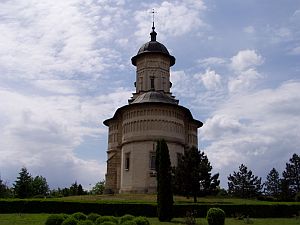
| ||
| The church of Cetăţuia Monastery |
When you leave the monastery and walk around it, you can enjoy a nice view over the whole valley and Iaşi. Among the industrial and residential areas you will see other monasteries - all in all, there are not less than seven in and around Iaşi. They all have one thing in common: All of them were recently rebuilt or at least restored. Many Romanians are religious, and so you will soon notice that the majority of Romanians crosses themselves when they pass a church, a cross or a clergyman. Even when they're sitting in a bus or a train.
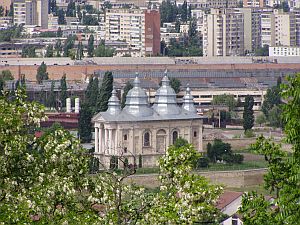
| ||
| A view of Frumuosa Monastery |
It's a ten-minutes walk from the top of the hill to Frumuoasa Monastery at the foot of the hill. The facility is like a oasis in the urban desert. Wide parts have been restored recently. Today, some nuns live and work (and pray of course) in the monastery, but it's possible to go inside.
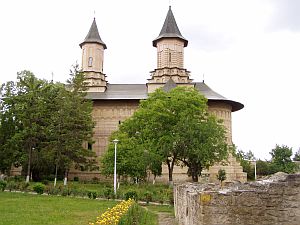
| ||
| Recently rebuilt Galata Monastery |
After another 15-minutes or so walk you can get to Galata Monastery, which is also protected by massive walls and towering above the town. Galata is one of the oldest monasteries in town. The monastery, resp. the church, seems to be very popular with the citizens as a wedding place.
Despite the fact that not many travelers find their way to Iaşi, there's plenty of accommodation. Some hotels concentrate in the area around Piaţa Unirii. Among them is the somehow old-fashioned but very clean Hotel Continental, less than 100 metres away from Piaţa Unirii. A double room incl. breakfast (with coffee!!!) and shared toilet+bathroom costs 790,000 Lei (€ 20). There's a simple bar in the ground floor. Address: Str. Cuza Vodă 4, Tel.: (032)-114-320.
The Lonely Planet as well as our Japanese guidebook recommended the restaurant Casa Bolta Rece. We understood why. The restaurant occupies a nice cellar and has great Romanian and Moldovan food. The quality is great and prices are reasonable (the two of us paid 200,000 Lei, around € 5, for an opulent dinner). It's hidden between small houses outside the centre and a little bit hard to find. Address: Str. Rece 10.
Two warnings: Don't go to restaurant VIPO (Horia/Cloşca) ! The quality is more than lousy and prices are higher than in Bolta Rece. No 2 refers to Restaurant Zefir (Cuza Vodă): The front part seems to be used as a night club, the restaurant occupies a separate part in the back. Staff were incredibly friendly, but the food was just ... bad. Next to the restaurant there's a brand new hostel - from outside, it looks very nice and might be worth a try.
- www.iasi.ro Official website of Iasi and quite useful. English version available.
- dacia.free.fr/roumanie/photos/iasi.htm Many pictures from Iaşi. The rest is in French only.
- www.virtualtourist.com/m/294d9/7de80/ Extensive website and nice pics from a Iaşi citizen. English.
Do you have or do you know a good website about Iaşi? Don't hesitate, let me know! After checking it, I would love to add it to the link list. You can submit a link by using the →contact form. Note that commercial websites will be treated differently.
P??ter wrote:
There is a Hungarian name for Iasi: "J??szv??s??r", although that part of Romania has never been part of the historical Hungary. You'll find this name of the city on wikipedia, too. Still, the name might incorporate interesting facts. "V??s??r" means a maket place, but "j??sz" or rather "J??szs??g" is a region in Hungary... the district or rather judetul - if the Romanian dimensions of a district are taken into consideration - is called "J??sz-Nagykun-Szolnok megye". If we can trust the information on wikipedia, Iasi was inhabited by this population called "j??sz" (yaas) and later on, they moved to the place what is now "J??szs??g" (yaas-shaag), and Iasi was re-inhabited by Romanians. But I know, we have to be cautious with all information provided by wikipedia. :-)
Posted by P??ter on July 9, 2008 00:08
©2024 Europe-East.com

 Albania
Albania Romania
Romania